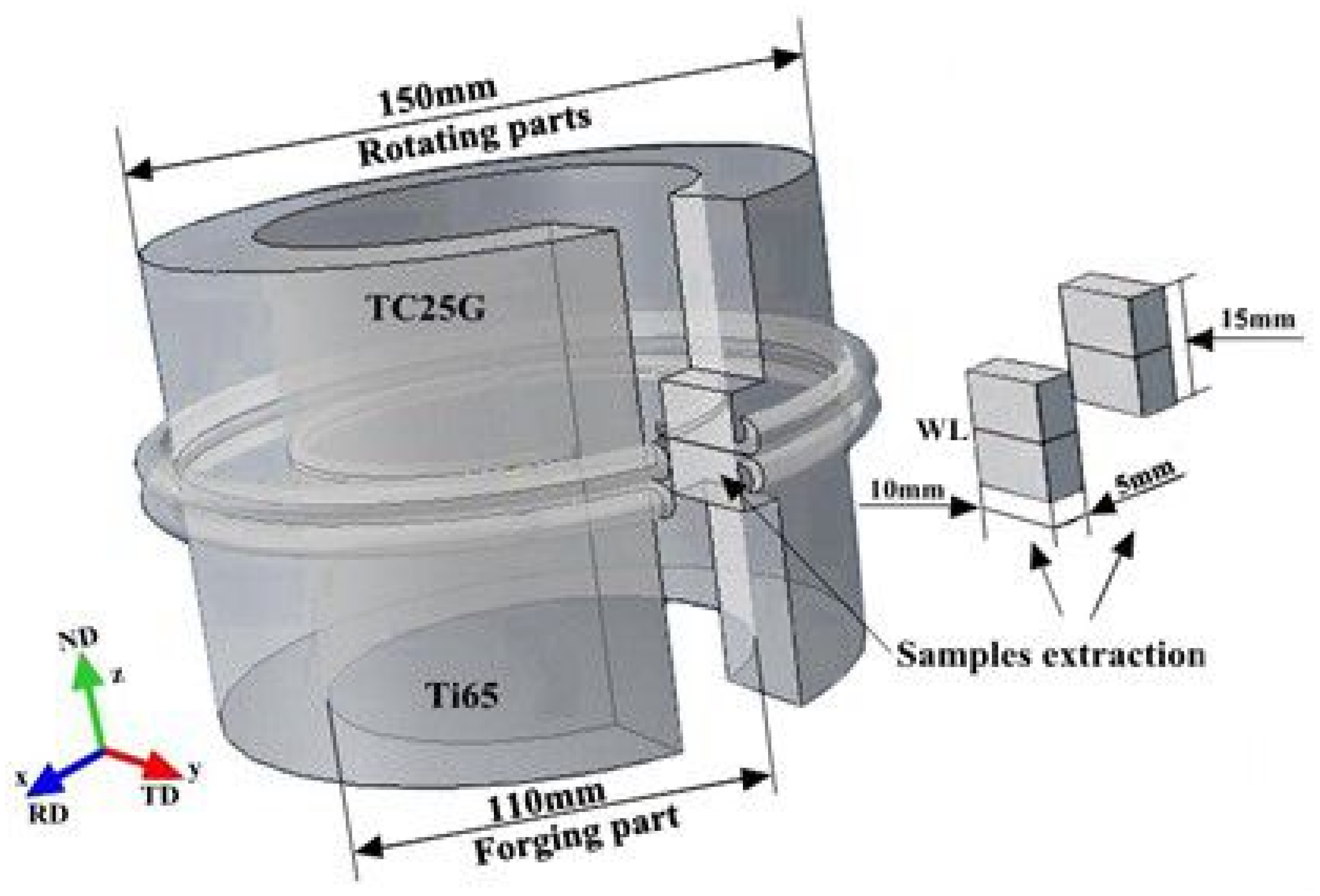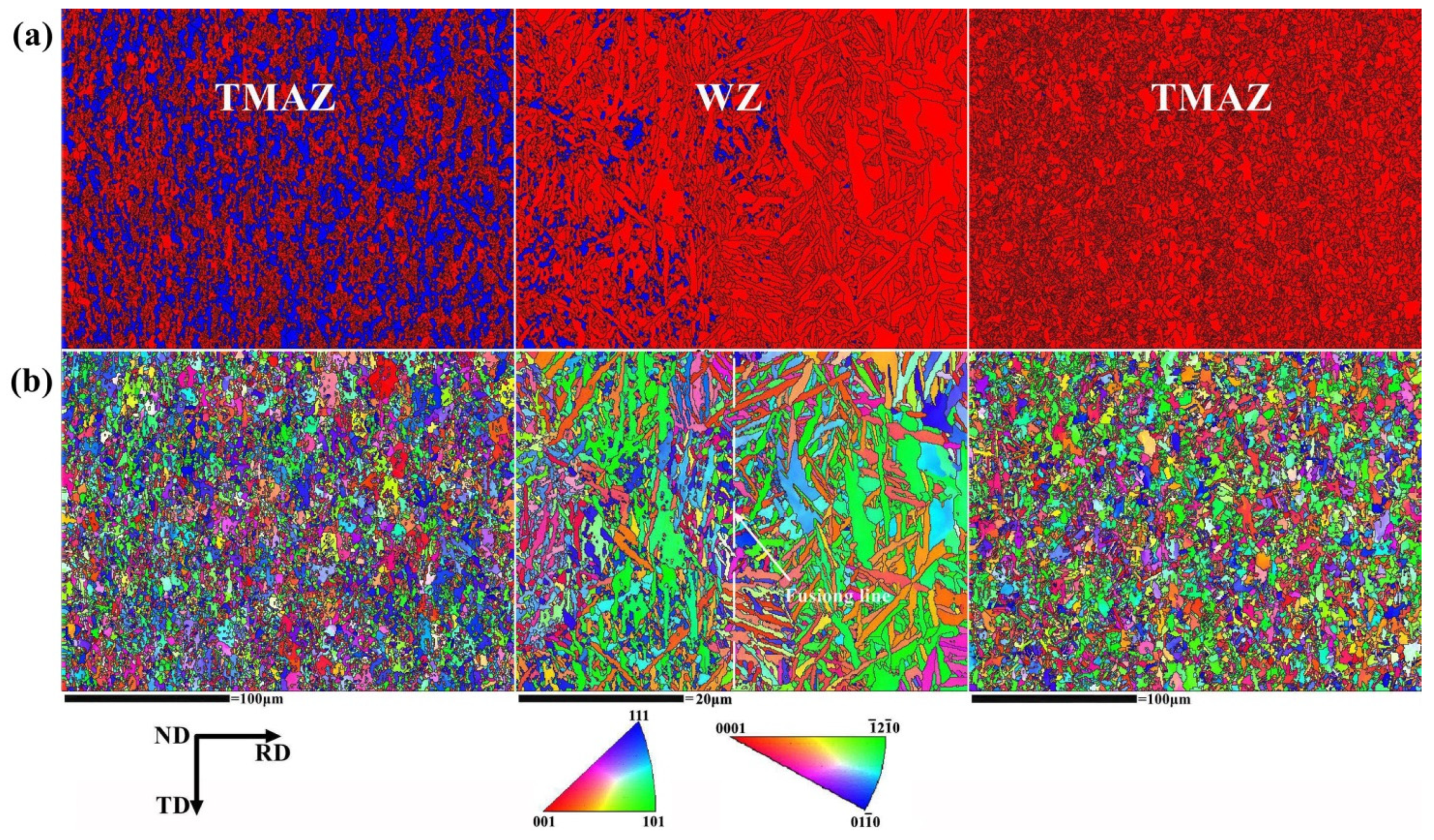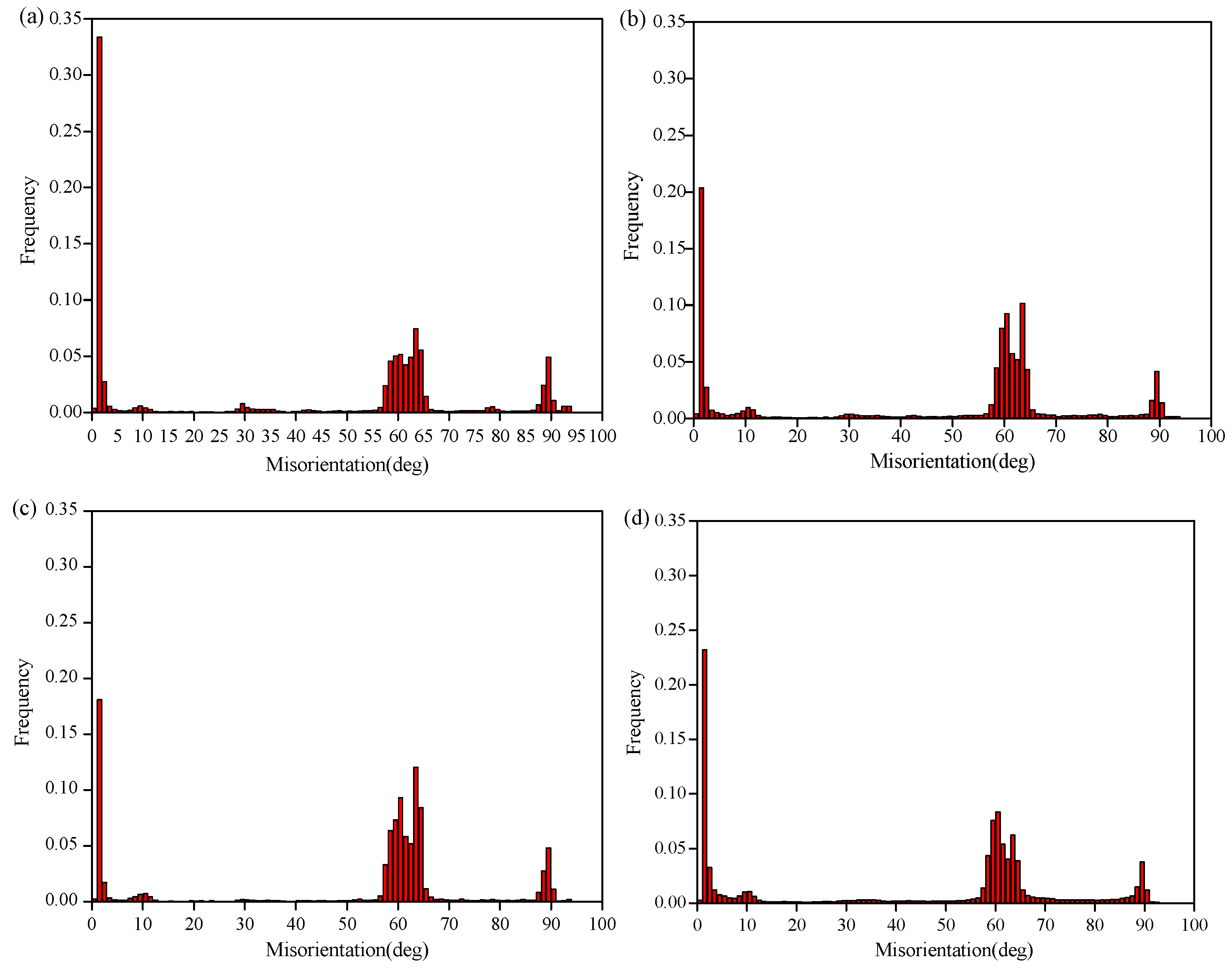Investigations into the Microstructure and Texture Evolution of Inertia-Friction-Welded Dissimilar Titanium Alloys
Abstract
:1. Introduction
2. Material and Experiments
3. Results and Discussion
4. Conclusions
- TC25G and Ti65 dissimilar titanium alloys have good performance in inertia friction welding, and a high-quality welding interface can be obtained under reasonable welding process parameters.
- The width of the weld zone and the thermo-mechanically affected zone on the side of the TC25G alloy are narrower and wider compared with the Ti65 alloy side due to the higher β-transus and high temperature resistance of the TC25G alloy.
- Refined, equiaxial β grains and an interdiffusion band of approximately 25 μm are formed in the weld zone under the high temperature and plastic deformation of IFW.
- The weld zone and thermo-mechanically affected zone formed a α texture and β texture, respectively.
Author Contributions
Funding
Data Availability Statement
Conflicts of Interest
References
- Hewitt, J.S.; Davies, P.D.; Thomas, M.J.; Garratt, P.; Bache, M.R. Titanium alloy developments for aeroengine fan systems. Mater. Sci. Technol. 2014, 30, 1919–1924. [Google Scholar] [CrossRef]
- Huang, C.F. Modern aeroengine integral blisk and its manufacturing technology. Aeronaut. Manuf. Technol. 2006, 4, 94–100. [Google Scholar]
- Zhang, H.Y.; Zhang, L.F. Development Overview of Aeroengine Integral Blisk and Its Manufacturing Technology at Home and Abroad. Aeronaut. Manuf. Technol. 2013, 23, 38–41. [Google Scholar]
- Li, W.Y.; Suo, J.D.; Ma, T.J.; Feng, Y.; Kim, K.H. Abnormal microstructure in the weld zone of linear friction welded Ti-6.5Al-3.5Mo-1.5Zr-0.3Si titanium alloy joint and its influence on joint properties. Mater. Sci. Eng. A 2014, 599, 38–45. [Google Scholar] [CrossRef]
- Nicholas, E.D.; Thomas, W.M. A review of friction processes for aerospace applications. Int. J. Mater. Prod. Technol. 1998, 13, 45–55. [Google Scholar]
- Xiao-Ling, D. The Achievements of Advanced Manufacturing Techniques in Aviation and Aerospace Industries. Int. J. Plant Eng. Manag. 2012, 3, 145–152. [Google Scholar]
- Attallah, M.M. Welding and Joining of Aerospace Materials||Inertia friction welding (IFW) for aerospace applications. Weld. Join. Aerosp. Mater. 2012, 4, 25–74. [Google Scholar]
- Sol, I.D.; Rivero, A.; de Lacalle, L.N.L.; Gamez, A.J. Thin-Wall Machining of Light Alloys: A Review of Models and Industrial Approaches. Materials 2019, 12, 2012. [Google Scholar] [CrossRef]
- Senkov, O.N.; Mahaffey, D.W.; Semiatin, S.L. Effect of process parameters on process efficiency and inertia friction welding behavior of the superalloys LSHR and Mar-M247. J. Mater. Process. Technol. 2017, 250, 156–168. [Google Scholar] [CrossRef]
- Tiley, J.S.; Mahaffey, T.; Alamb, D.W. Strengthening mechanisms in an inertia friction welded nickel-base superalloy. Mater. Sci. Eng. A 2016, 662, 26–35. [Google Scholar] [CrossRef]
- Guo, W.; You, G.; Yuan, G.; Zhang, X. Microstructure and mechanical properties of dissimilar inertia friction welding of 7A04 aluminum alloy to AZ31 magnesium alloy. J. Alloys Compd. 2017, 695, 3267–3277. [Google Scholar] [CrossRef]
- Ding, Y.H.; You, G.Q.; Wen, H.Y.; Li, P.; Tong, X.; Zhou, Y. Microstructure and mechanical properties of inertia friction welded joints between alloy steel 42CrMo and cast Ni-based superalloy K418. J. Alloys Compd. 2019, 803, 176–184. [Google Scholar] [CrossRef]
- Ma, H.; Qin, G.L.; Geng, P.H.; Wang, S.; Zhang, D. Microstructural characterisation and corrosion behaviour of aluminium alloy/steel hybrid structure produced by friction welding. J. Manuf. Process. 2021, 61, 349–356. [Google Scholar] [CrossRef]
- Wu, W.; Zhu, L.Y.; Wu, G.F.; Bin Xu, H. Study on Performance of Inertia Radial Friction Welding of Copper-Alloy to 35CrMnSi Steel. Adv. Mater. Res. 2011, 291–294, 968–974. [Google Scholar] [CrossRef]
- Ballat-Durand, D.; Bouvier, S.; Risbet, M.; Pantleon, W. Through analysis of the microstructure changes during linear friction welding of the near-α titanium alloy Ti-6Al-2Sn-4Zr-2Mo (Ti6242) towards microstructure optimization. Mater. Charact. 2019, 151, 38–52. [Google Scholar] [CrossRef]
- Boyat, X.; Ballat-Durand, D.; Marteau, J.; Bouvier, S.; Favergeon, J.; Orekhov, A.; Schryvers, D. Interfacial characteristics and cohesion mechanisms of linear friction welded dissimilar titanium alloys: Ti-5Al-2Sn-2Zr-4Mo-4Cr(Ti17) and Ti-6Al-2Sn-4Zr-2Mo(Ti6242). Mater. Charact. 2019, 158, 109942. [Google Scholar] [CrossRef]
- Du, S.; Gao, M.; Xu, W.; Wang, X. Study on Interface of Linear Friction Welded Joint Between TC11 and TC17 Titanium Alloy. Acta Metall. Sin. 2019, 55, 885–892. [Google Scholar]
- Tao, B.; Li, Q.; Zhang, Y.; Zhang, T.; Liu, Y. Effects of post-weld heat treatment on fracture toughness of linear friction welded joint for dissimilar titanium alloys. Mater. Sci. Eng. A 2015, 634, 141–146. [Google Scholar] [CrossRef]
- Garcia, J.M.; Esin, V.A.; Morgeneyer, T.F. Strength, fatigue strength and toughness of dissimilar Ti17–Ti64 linear friction welded joints: Effect of soft surface contamination and depletion of α precipitates. Mater. Sci. Eng. A 2020, 799, 139989. [Google Scholar] [CrossRef]
- Zhanglong, Z.; Xuyang, S.; Lanchuan, C.; Wenxin, X.; Zekun, Y.; Hongzhen, G. The effect of isothermal deforming on the microstructure and property of inertial friction welding IMI834/Ti6246 dual titanium alloy. Rare Met. Mater. Eng. 2020, 49, 2388–2392. [Google Scholar]
- He, J.H.; Zhang, T.C.; He, S.C. Research of Microstructure and Mechanical Properties of Ti600/TC17 Inertia Friction Welding Joints. J. Mech. Eng. 2017, 53, 95–100. [Google Scholar] [CrossRef]
- Liu, Y.H.; Zhao, Z.B.; Zhang, C.; Wang, Q.; Sun, H.; Li, N. Thermal and mechanical induced texture evolution of inertia friction welding in α + β titanium alloy. Mater. Lett. 2020, 277, 128329. [Google Scholar] [CrossRef]
- Wu, Y.Q.; Zhang, C.B.; Zhou, J.; Liang, W.; Li, Y. Analysis of the Microstructure and Mechanical Properties during Inertia Friction Welding of the Near-α TA19 Titanium Alloy. Chin. J. Mech. Eng. 2020, 33, 13. [Google Scholar] [CrossRef]
- Wen, G.D.; Ma, T.J.; Li, W.Y.; Wang, S.Q.; Guo, H.Z.; Chen, D.L. Strain-controlled fatigue properties of linear friction welded dissimilar joints between Ti-6Al-4V and Ti-6.5Al-3.5Mo-1.5Zr-0.3Si alloys. Mater. Sci. Eng. A 2014, 612, 80–88. [Google Scholar] [CrossRef]





| Element | Ti | Al | Mo | Nb | Zr | Sn | Si | W | Ta | |
|---|---|---|---|---|---|---|---|---|---|---|
| Wt% | TC25G | Bal | 6.60 | 3.98 | - | 3.64 | 1.89 | 0.21 | 1.00 | - |
| Ti65 | Bal | 5.81 | 0.50 | 0.27 | 3.41 | 4.16 | 0.39 | 0.78 | 1.02 | |
Disclaimer/Publisher’s Note: The statements, opinions and data contained in all publications are solely those of the individual author(s) and contributor(s) and not of MDPI and/or the editor(s). MDPI and/or the editor(s) disclaim responsibility for any injury to people or property resulting from any ideas, methods, instructions or products referred to in the content. |
© 2023 by the authors. Licensee MDPI, Basel, Switzerland. This article is an open access article distributed under the terms and conditions of the Creative Commons Attribution (CC BY) license (https://creativecommons.org/licenses/by/4.0/).
Share and Cite
Zhou, J.; Wu, Y.; Zhang, C.; Liang, W.; Li, R.; Qin, F. Investigations into the Microstructure and Texture Evolution of Inertia-Friction-Welded Dissimilar Titanium Alloys. Metals 2023, 13, 1575. https://doi.org/10.3390/met13091575
Zhou J, Wu Y, Zhang C, Liang W, Li R, Qin F. Investigations into the Microstructure and Texture Evolution of Inertia-Friction-Welded Dissimilar Titanium Alloys. Metals. 2023; 13(9):1575. https://doi.org/10.3390/met13091575
Chicago/Turabian StyleZhou, Jun, Yanquan Wu, Chunbo Zhang, Wu Liang, Rui Li, and Feng Qin. 2023. "Investigations into the Microstructure and Texture Evolution of Inertia-Friction-Welded Dissimilar Titanium Alloys" Metals 13, no. 9: 1575. https://doi.org/10.3390/met13091575
APA StyleZhou, J., Wu, Y., Zhang, C., Liang, W., Li, R., & Qin, F. (2023). Investigations into the Microstructure and Texture Evolution of Inertia-Friction-Welded Dissimilar Titanium Alloys. Metals, 13(9), 1575. https://doi.org/10.3390/met13091575





